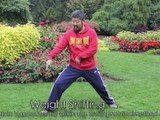Author: Chen Zhonghua Language: English Length: 20:45 minutes Location: Edmonton
Description: Master Chen teaches the medium horse stance and the 1/3 theory of Chen Style Taijiquan Practical Method.
Horse Stance Online Video Trailer
Previous post: Lessons from Hong Junsheng
Next post: Chen Taiji Practical Method – Winnipeg,MB (2010 – 2011)



{ 2 comments… read them below or add one }
In the Chen style Taijiquan Practical Method we are taught to always keep our dantien in the center and to never toss the dantien nor the spine forward, backward, nor side to side. To do that is to lose structure which leads to loss of power.
“How can one then move in such a rigid posture?” (Some may ask). “Isn’t that double heavy”, others might say. First of all, according to the principles of Chen style Taijiquan written in both Chen Xin’s and Wang Zong Yue’s books, and as taught by Chen Fake and Hong Junsheng, double heavy is not about weight distribution, but about body coordination. Also the teachings of the mentioned masters required that a central equilibrium in motion be kept where the center does not move, but acts as a fulcrum.
“How then do we move by keeping those “rigid” standards of postures?” The answer lies in the proper use of the kuas and the unique posture of Chen style Taijiquan called the Half Horse Stance. In this video, Master Chen Zhonghua teaches you the details of this posture and how something can be rigid and mobile at the same time satisfying the Taiji principle of contradictory conformity where yin and yang are always present in everything.
Weight shifting can be accomplished without tossing the center around and, most importantly, without your opponent realizing what you are doing. Theory with Master Chen is always backed up by action and demonstrations of him applying what he says, and showing how it works in relation to applying it martially on an opponent. Weight shifting, only necessary movement, and maintaining a powerful structure is possible in Taijiquan by learning how to master the Half Horse Stance. With this video you will learn how to set up the basis for practice of this unique martial arts posture.
The 1/3, 2/3 Rule was very enlightening. I think it helps with identifying a location for rotation. It made me think of The Hinge video, which I haven’t seen, but I felt like I found a good place to have a hinge with applying the 1/3, 2/3 Rule.
I particularly liked the line can be a stretch or a squeeze. The squeeze was especially relevant to my recent practice. I’ve been working on fixing points and pushing or pulling them through my form. Bringing the line in by squeezing made a big difference. I now understand one of the lessons Master Chen was trying to teach me in Edmonton this summer.